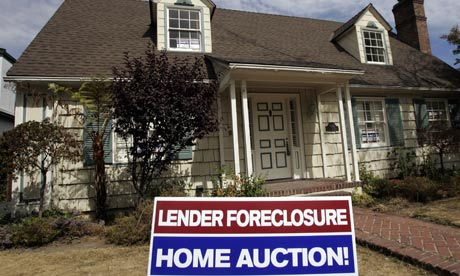
A home advertised for sale at a foreclosure auction in Pasadena, California. Photograph: Reed Saxon/AP
Big announcements of breakthrough legislative deals during election campaigns should be taken with huge grains of salt. Generally more rhetoric than reality, they sometimes contain real concessions made by politicians seeking votes. So it is with Thursday's Washington announcement of $25bn to help homeowners. Something significant is happening, but it lies below the surface of the headlines.
Typically, modern governments intervene in two ways when – as has been true since 2007 – free-enterprise capitalist economies produce particularly bad versions of their recurring economic "downturns". One economic policy is aptly called "trickle down" economics. It involves throwing heaps of money at the top of the economic pyramid – to mammoth banks, insurance companies, and other corporations at or near economic collapse. Policy-makers hope that such help for these institutions will revive their activity and thereby trickle down – as credit and orders for medium-sized and small businesses, and then, finally, to jobs and maybe wage increases for the majority of workers.
The alternative is "trickle up" economic policy. It involves government financial aid aimed chiefly at helping the mass of workers. That policy's goal is for the assisted workers to resume purchasing, which will, in turn, boost business revenues and so rebuild prosperity.
The historical record is quite clear: trickle down is no better or more effective a policy to end deep recessions and depressions than trickle up. In the last great capitalist downturn of the 1930s, the Roosevelt administration first tried trickle down. Its poor results, coupled with profound political pressures from below – the Congress of Industrial Organizations (CIO) membership drives that brought new millions into labor unions and the surging socialist and communist parties – forced Roosevelt to add major trickle up policies. They worked better, but not well enough to overcome the Great Depression.
Of course, large corporations, their shareholders and stock markets prefer trickle down. They get bailed out and they "recover", while the rest of us watch to see what may or may not trickle down. The US working class has been waiting for over four years. Precious little has yet trickled down. The majority of citizens prefer trickle up and for parallel reasons. Which kind of policy prevails depends on which side wields more power over the policy-makers.
Under Bush and Obama, trickle down has dominated overwhelmingly since the current crisis began in 2007. There were a few trickle-up measures: modest individual income tax cuts, repeated but very ineffective efforts to help those subjected to foreclosure, and extensions of unemployment compensation benefits. However, they were utterly dwarfed by what the Treasury and the Fed poured out in trickle-down bailouts. By 2011, it was clear that the Bush-Obama trickle-down policy had failed to end this second-worst economic downturn in a century.
The Obama team was beginning to learn what the Roosevelt team had learned sooner in their Great Depression. It turns out that bailouts for the top of the economic pyramid, which never trickle down, leave an economically depressed mass at the bottom. Governments that also try to pay for trickle-down policies by imposing "austerity programs" on the bottom only make matters worse. Sustained depression at the bottom eventually threatens the top: first economically and then also politically.
That happened sooner and more powerfully in the more depressed and more politically mobilized conditions of the 1930s. But the Tea Parties and the Occupy Wall Street movement, in their radically different ways, suggest something comparable unfolding now in the US. In Europe, the process is further along, as the Greek example shows.
The Obama team began in 2011 to supplement a wholly inadequate trickle-down approach with some limited trickle-up elements. The biggest of these have been the reductions in the social security deduction on paychecks. Another small step is this week's modest help for homeowners facing foreclosures. It will not help the majority of those in such danger – for example, the 50% of mortgages owned by Fannie Mae and Freddy Mac are ineligible. It will help the rest, but not much.
Consider simply that the negative equity of US homeowners is estimated now at $ 700bn. That is how much more they owe on their homes than those homes are worth. This new bill proposes $26bn in aid for that problem. No such timidity attended the trillions provided for the trickle-down bailouts since 2007. The banks are happy with this proposed settlement's low cost to them.
While the government's help to homeowners is far from adequate or just, it represents a partial and late recognition of trickle-down economics' inadequacy as policy. It further concedes the need for some trickle up. What happens next depends on the evolution of this crisis and of the political forces gathering strength.
Those factors will determine how long the beneficiaries of trickle-down economics can sustain the policy's dominance and continue to shift its costs onto the mass of people through austerity programs. Those same factors will also determine whether we see next a further shift to trickle-up economics – or a more basic challenge to an economic system whose instability is so severe and so socially costly.
No comments:
Post a Comment